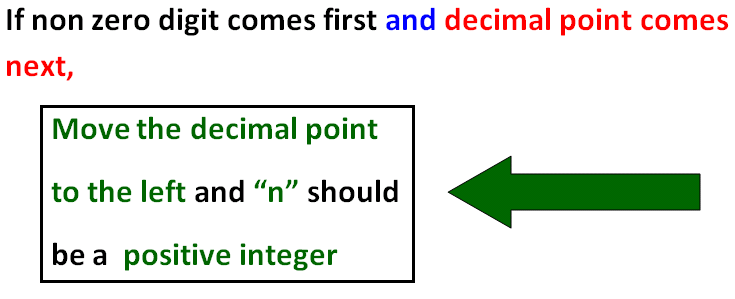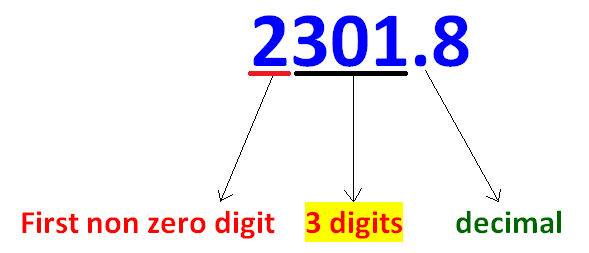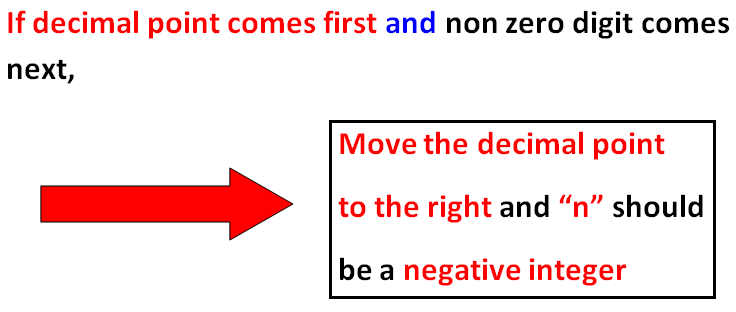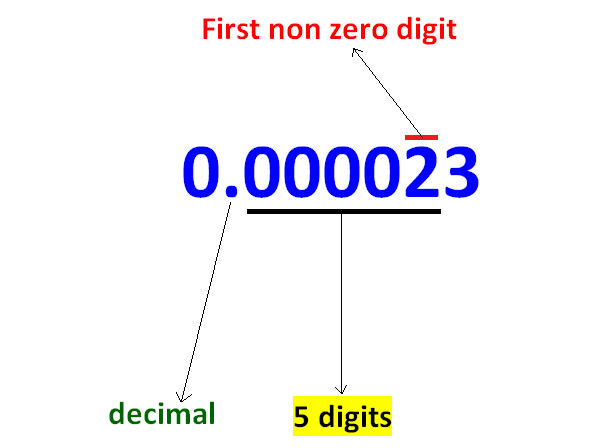CONVERT BETWEEN STANDARD AND SCIENTIFIC NOTATION
Subscribe to our ▶️ YouTube channel 🔴 for the latest videos, updates, and tips.
Scientific notation is a standard way of writing very large and very small numbers so that they’re easier to both compare and use in computations.
Standard Form to Scientific Notation
Every number in the scientific notation must be in the form of
a x 10n
where 1 ≤ a < 10 and n must be a positive or negative integer.
To convert a number to scientific notation, first we have to identify where the decimal point and non zero digit come.
There are two cases in it.
Case 1 :

To move the decimal point to the left, we have to count number of digits as explained in the example given below.

According to the example given above, we have to move the decimal point 3 digits to the left and exponent of 10 should be 3 (positive integer)
When we do so, we get the scientific notation of the given number.
So,
2301.8 = 2.3018 x 103
Case 2 :

To move the decimal point to the right, we have to count number of digits as explained in the example given below.

According to the example given above, we have to move the decimal point 5 digits to the right and exponent of 10 should be -5 (negative integer)
When we do so, we get the scientific notation of the given number.
So,
0.000023 = 2.3 x 10-5
Important Note:
If we don't find decimal point at anywhere of the given number, we have to assume that there is decimal point at the end of the number.
For example,
2300000 -------------> 2300000.
Here, the non zero digit comes first and decimal point comes next. So we have to apply case 1 to convert this number into scientific notation.
Scientific Notation to Standard Form
To convert a number from scientific notation to standard notation, first we have to notice the exponent of 10 in scientific notation.
If the exponent of 10 is positive, we have to move the decimal point to the right.
For example, if you have 103, you have to move the decimal point 3 digits to the right.
If the exponent of 10 is negative, we have to move the decimal point to the right.
For example, if you have 10-5, you have to move the decimal point 5 digits to the left.
Solved Examples
Examples 1-3 : Write the given number in standard form.
Example 1 :
5.236 x 105
Solution :
Here, the exponent of 10 is positive 5. So we have to move the decimal point five digits to the right.
In 5.236, we have only three digits after the decimal point.
So, we have to add two zeros to move the decimal point five digits to the right.
Therefore, the standard form of 5.236 x 105 is
523600
Example 2 :
6.415 x 10-6
Solution :
Here, the exponent of 10 is negative 6. So we have to move the decimal point six digits to the left.
In 6.415, we have only 1 digit before the decimal point.
So, we have to add five zeros to move the decimal point six digits to the left.
Therefore, the standard form of 6.415 x 10-6 is
0.000006415
Example 3 :
2.0 x 107
Solution :
Here, the exponent of 10 is positive 7. So we have to move the decimal point seven digits to the right.
In 2.0, we have one zero to the right of the decimal point.
So, we have to add six more zeros to move the decimal point seven digits to the right.
Therefore, the standard form of 2.0 x 107 is
20000000
Examples 4-6 : Write the given number in scientific notation.
Example 4 :
4580245
Solution :
Here, we don't find decimal point in 4580245. So we have to assume that there is decimal point at the end .
Then,
4580245 ---------> 4580245.
Here, non zero digit comes first and decimal point comes next.
We have to move the decimal point to the left.
There are six digits between the 1st non zero digit and the decimal point.
So, the decimal point has to be moved six digits to the left and exponent of 10 should be 6 (positive integer).
Therefore, the scientific notation of 4580245 is
4.4580245 x 106
Example 5 :
325.8645
Solution :
325.8645
Here, non zero digit comes first and decimal point comes next.
We have to move the decimal point to the left.
There are two digits between the 1st non zero digit and the decimal point.
So, the decimal point has to be moved two digits to the left and exponent of 10 should be 2 (positive integer).
Therefore, the scientific notation of 325.8645 is
3.258645 x 102
Example 6 :
0.0008743
Solution :
Here, decimal point comes first and non zero digit comes next.
We have to move the decimal point to the right.
There are for digits from the decimal point up to the first 1st non zero digit.
So, the decimal point has to be moved four digits to the right and exponent of 10 should be -4 (negative integer).
Therefore, the scientific notation of 0.0008743 is
8.743 x 10-4
Subscribe to our ▶️ YouTube channel 🔴 for the latest videos, updates, and tips.
Kindly mail your feedback to v4formath@gmail.com
We always appreciate your feedback.
©All rights reserved. onlinemath4all.com
Recent Articles
-
10 Hard SAT Math Questions (Part - 38)
Dec 08, 25 12:12 AM
10 Hard SAT Math Questions (Part - 38) -
SAT Math Practice
Dec 05, 25 04:04 AM
SAT Math Practice - Different Topics - Concept - Formulas - Example problems with step by step explanation -
10 Hard SAT Math Questions (Part - 37)
Dec 03, 25 07:02 AM
10 Hard SAT Math Questions (Part - 37)


